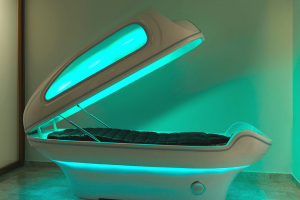Full Body Hyperthermia
This therapy combines the therapeutic benefits of a traditional sauna with those of Infrared heat. Only your head is outside of the hyperthermia unit. It is a non-invasive, safe and holistic treatment that has no side effects when administered correctly and to patients that are in a condition to receive it.
On the subject of treatments that she approved, Dr. Budwig writes in her book Der Tod des Tumors (Bd. 2) [The Death of the Tumor, Vol. 2], on page 143: “What other therapeutic measures are advisable, permitted, recommended? I always reply: Everyone should do what they can – cold water treatments, hyperthermia, homeopathy, phytotherapy (herbs), even psychotherapy, or sometimes even surgical intervention, depending on the situation.”
Dr. Johanna Budwig directed her cancer patients to soak up some 20 minutes of direct sunlight every day (1), which provides infrared heat, a type of heat that is also present in sauna hyperthermia systems.
How Does Hyperthermia Work?
With Whole Body Hyperthermia, heat is applied to the entire body and the heat produced by the photon device can reach 46ºC, raising the body temperature to the ideal 38º Celsius, thus inducing a natural fever.
Some photon devices have an inside cover of ceramic fiber and consist of a sophisticated thread of ceramic that emits infrared rays using the alloys of 3 metals: Platinum, titanium, and aluminum. The ceramic fiber has the capacity of emitting more infrared energy as the temperature rises, becoming extremely effective in treating certain pathologies.
Hyperthermia sessions last an average of 1 hour.

The Benefits of Full Body Hyperthermia
- Activates the lymph system, our cleansing system, thus promoting the elimination of waste
- Anti-inflammatory properties, alleviating joint and muscular pain
- Stimulates the immune system
- Inhibits bacterial growth
- Diminishes fatty acids, making it less likely for these to rest in the arteries
- Produces a speedy elimination of lactic acid in the muscles
- Improves skin’s cell activity and has an energetic toning effect
Comments from the National Cancer Institute
Research has shown that high temperatures can damage and kill cancer cells, usually with minimal injury to normal tissues (2). By killing cancer cells and damaging proteins and structures within cells (3), hyperthermia may shrink tumors… Hyperthermia can also enhance the effects of certain anticancer drugs.
With hyperthermia you are basically accomplishing three things; removing accumulations of toxic chemicals that cause tumors and disease, improving circulation so that tissues are both nourished with oxygen and flushed of acidic wastes and weakening or even accelerating the death of tumor cells that have a lower tolerance to heat than healthy cells.
CONTRAINDICATIONS
Hyperthermia should not be applied if the patient has had lymph nodes removed in the armpit region, if there is a risk of convulsions or epileptic attacks or if you are claustrophobic and cannot tolerate laying down on your back for 1 hour. Other effective therapies would be recommended if hyperthermia is not a viable option.
What Types Of Cancer Has Hyperthermia Been Used On?
- Acute Lymphoblastic Leukemia (ALL)
- Acute Myeloid Leukemia (AML)
- Adrenocortical Carcinoma
- Kaposi Sarcoma
- Primary CNS Lymphoma
- Anal Cancer
- Appendix Cancer
- Astrocytomas
- Basal Cell Carcinoma
- Bile Duct Cancer
- Bladder Cancer
- Bone Cancer
- Ewing Sarcoma
- Osteosarcoma and Malignant Fibrous Histiocytoma
- Ependymoma
- Breast Cancer
- Bronchial Tumors
- Burkitt Lymphoma
- Non-Hodgkin Lymphoma
- Carcinoid Tumor
- Gastrointestinal cancer
- Lymphoma
- Cervical Cancer
- Cholangiocarcinoma
- Chronic Myeloproliferative Neoplasms
- Colon Cancer
- Colorectal Cancer
- Cutaneous T-Cell Lymphoma
- Ductal Carcinoma In Situ (DCIS)
- Endometrial Cancer
- Esophageal Cancer
- Ewing Sarcoma
- Intraocular Melanoma
- Retinoblastoma
- Fallopian Tube Cancer
- Gallbladder Cancer
- Gastric (Stomach) Cancer
- Ovarian cancer
- Testicular cancer
- Gestational Trophoblastic Disease
- Hairy Cell Leukemia
- Head and Neck Cancer
- Hepatocellular (Liver) Cancer
- Histiocytosis
- Langerhans Cell
- Hodgkin Lymphoma
- Hypopharyngeal Cancer
- Islet Cell Tumors
- Pancreatic Neuroendocrine Tumors
- Kidney cancer
- Renal Cell cancer
- Laryngeal Cancer
- Chronic Lymphocytic (CLL)
- Lip and Oral Cavity Cancer
- Lung Cancer
- Malignant Fibrous Histiocytoma of Bone and Osteosarcoma
- Melanoma
- Merkel Cell Carcinoma
- Malignant Mesothelioma
- Mouth Cancer
- Multiple Myeloma/Plasma Cell Neoplasm
- Mycosis Fungoides
- Myelodysplastic Syndromes
- Myelodysplastic/Myeloproliferative Neoplasms
- Nasal Cavity and Paranasal Sinus Cancer
- Nasopharyngeal Cancer
- Neuroblastoma
- Pancreatic Cancer
- Parathyroid Cancer
- Penile Cancer
- Pharyngeal Cancer
- Prostate Cancer
- Rectal Cancer
- Renal Pelvis and Ureter
- Transitional Cell Cancer
- Salivary Gland Cancer
- Osteosarcoma (Bone Cancer)
- Uterine Cancer
- Skin Cancer
- Small Cell Lung Cancer
- Small Intestine Cancer
- Soft Tissue Sarcoma
- Urethral Cancer
- Uterine Cancer
- Endometrial Cancer
- Vaginal Cancer and Vulvar Cancer
Additional Information and References
(1) Budwig, J. Flax Oil as a True Aid Against Arthritis, Heart Infarction, Cancer and Other Diseases. Vancouver: Apple Publishing, 1996. Pg. 53
(2) To learn more about clinical trials, call NCI’s Cancer Information Service (CIS) at 1–800–4–CANCER (1–800–422–6237) or visit Clinical Trials Information for Patients and Caregivers.
(3) Wust P, Hildebrandt B, Sreenivasa G, et al. Hyperthermia in combined treatment of cancer. The Lancet Oncology 2002; 3(8):487–497. [PubMed Abstract]